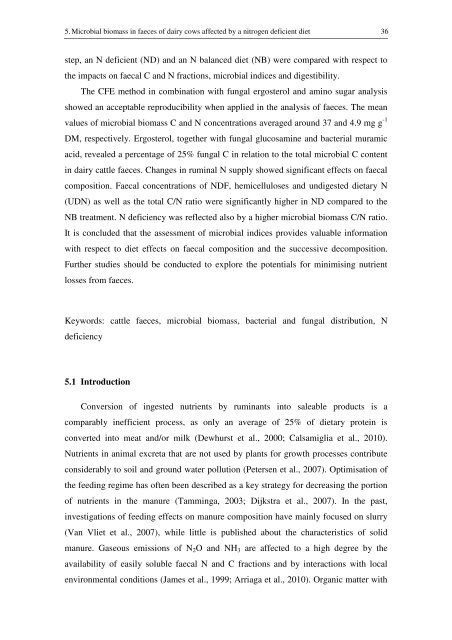Fütterungsbedingte mikrobielle Zusammensetzung von Rinderkot ...
Fütterungsbedingte mikrobielle Zusammensetzung von Rinderkot ...
Fütterungsbedingte mikrobielle Zusammensetzung von Rinderkot ...
You also want an ePaper? Increase the reach of your titles
YUMPU automatically turns print PDFs into web optimized ePapers that Google loves.
5. Microbial biomass in faeces of dairy cows affected by a nitrogen deficient diet 36<br />
step, an N deficient (ND) and an N balanced diet (NB) were compared with respect to<br />
the impacts on faecal C and N fractions, microbial indices and digestibility.<br />
The CFE method in combination with fungal ergosterol and amino sugar analysis<br />
showed an acceptable reproducibility when applied in the analysis of faeces. The mean<br />
values of microbial biomass C and N concentrations averaged around 37 and 4.9 mg g -1<br />
DM, respectively. Ergosterol, together with fungal glucosamine and bacterial muramic<br />
acid, revealed a percentage of 25% fungal C in relation to the total microbial C content<br />
in dairy cattle faeces. Changes in ruminal N supply showed significant effects on faecal<br />
composition. Faecal concentrations of NDF, hemicelluloses and undigested dietary N<br />
(UDN) as well as the total C/N ratio were significantly higher in ND compared to the<br />
NB treatment. N deficiency was reflected also by a higher microbial biomass C/N ratio.<br />
It is concluded that the assessment of microbial indices provides valuable information<br />
with respect to diet effects on faecal composition and the successive decomposition.<br />
Further studies should be conducted to explore the potentials for minimising nutrient<br />
losses from faeces.<br />
Keywords: cattle faeces, microbial biomass, bacterial and fungal distribution, N<br />
deficiency<br />
5.1 Introduction<br />
Conversion of ingested nutrients by ruminants into saleable products is a<br />
comparably inefficient process, as only an average of 25% of dietary protein is<br />
converted into meat and/or milk (Dewhurst et al., 2000; Calsamiglia et al., 2010).<br />
Nutrients in animal excreta that are not used by plants for growth processes contribute<br />
considerably to soil and ground water pollution (Petersen et al., 2007). Optimisation of<br />
the feeding regime has often been described as a key strategy for decreasing the portion<br />
of nutrients in the manure (Tamminga, 2003; Dijkstra et al., 2007). In the past,<br />
investigations of feeding effects on manure composition have mainly focused on slurry<br />
(Van Vliet et al., 2007), while little is published about the characteristics of solid<br />
manure. Gaseous emissions of N2O and NH3 are affected to a high degree by the<br />
availability of easily soluble faecal N and C fractions and by interactions with local<br />
environmental conditions (James et al., 1999; Arriaga et al., 2010). Organic matter with
















